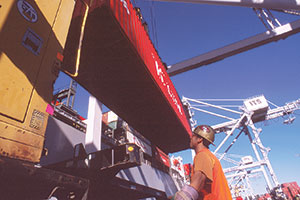West Coast Ports Start to Clear Backlog After Tentative Agreement With Union

This story appears in the March 2 print edition of Transport Topics.
West Coast port operators strived to accelerate operations last week after a tentative contract agreement was reached, but carrier executives and experts see hurdles before the supply chain gets humming again.
Dockworkers, carriers and shippers are tackling up to 500,000 shipments that coagulated during talks between the Pacific Maritime Association and the International Longshore and Warehouse Union, experts said. The tentative five-year deal, reached 285 days after talks began, covers 29 ports and 20,000 workers.
While a PMA spokesman said full operations have been restored, trucking executives such as Dick Coyle, president of California-based Devine Intermodal, saw immediate challenges.
“The long, arduous process of dealing with the backlog has begun,” said Coyle, who anticipates at least three months of disruptions. “It’s going to be a slog digging out.”
Others’ estimates, including the Port of Oakland, ranged from six to 10 weeks.
“It will take eight weeks or more before things begin to approach ‘normal,’ ” said FTR consultant and industry veteran Larry Gross.
He based his 500,000 estimate on historical port data and shipments that already were in terminals, on ships at anchor and freight en route.
“Lines are anxious to dump their cargo ASAP,” Coyle told Transport Topics. “They are very anxious to get their vessels into proper rotation. Hopefully, [cargo] will be discharged in an orderly fashion so we can deal with it efficiently.”
Coyle fears a repetition of chaos after the 2002 lockout, when some ships’ cargo was dumped at the nearest port, even if it wasn’t destined there.
Long-term issues remain, Intermodal Motor Carriers Conference Executive Director Curtis Whalen said.
“Once we get through the backlog, it is important to remember that being back to normal port operations isn’t good from a trucking standpoint.” Whalen said.
“Vessels were coming in with such large quantities of cargo that truckers backed up at the gate for hours,” even before the slowdowns, Whalen said. “There was a lack of chassis as well.”
Mixing cargo from multiple lines on a single vessel adds to the challenge, Gross said.
Chassis are a particularly thorny issue.
“We are fearful that the parties negotiated something that is beyond their power to negotiate,” Coyle said, specifically a rumored provision for ILWU inspection of chassis that are owned by others who aren’t party to the contract.
Neither side has disclosed chassis or other contract terms.
PMA wouldn’t say whether the tentative deal mirrored an early February offer including a 3% wage increase.
Whalen noted uncertainty surrounding a new Southern California chassis pool, slated for a Feb. 1 startup, that’s meant to alleviate equipment shortages.
When that pool, covering about 90% of chassis in the region, was announced last fall, a Feb. 1 startup was targeted. However, no confirmed date has been announced, and none of the leasing participants responded last week to Transport Topics’ request for details.
Readjusting the supply chain will have other consequences, Gross said, including higher eastbound freight rates.
“Shippers will be desperate to make up for lost time and to deploy inventory on depleted store shelves and into assembly plants as soon as possible,” he said. “Westbound rates will decline as carriers will be seeking every load available to deploy equipment back to the West Coast.”
Coyle cited another new obstacle.
Truckers now must deliver export loads no more than one day before a vessel departure, which reduces fleet operational flexibility. In the past, loads could be delivered up to three days before sailing.
Jeff Lang, CEO of East Wenatchee, Washington-based trucker and intermodal operator Eagle Group, told TT the company stopped doing pier work. “We were losing drivers because of delays in the port,” he said. “That’s something we can’t afford.”
He added, “We’d like to get back to doing those trips as long as we can get an acceptable dwell time. I don’t have a feel for how long it will take to get operations back to normal.”
An ILWU spokesman said the ratification process can take several months, with normal operations in place in the meantime.
“It’s good to know there is an agreement in place . . . but this still has to be ratified,” Whalen said.
Gross identified two factors that might reduce the back-log sooner.
One is ongoing diversions of cargo from the West Coast as shippers avoided the slowdown (see story above). The other is lower shipment levels because Asian factories closed after Lunar New Year began Feb. 19.
Los Angeles Mayor Eric Garcetti said “we celebrate” a return to work and outlined new operational steps, such as the chassis pool, to enhance competitiveness.
Local 13 President Bobby Olvera Jr. promised Americans, “We’ll make sure the Easter bunny arrives. Your goods are on the move.”

